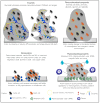Hidden Places for Foodborne Bacterial Pathogens and Novel Approaches to Control Biofilms in the Meat Industry
- PMID: 39766937
- PMCID: PMC11675819
- DOI: 10.3390/foods13243994
Hidden Places for Foodborne Bacterial Pathogens and Novel Approaches to Control Biofilms in the Meat Industry
Abstract
Biofilms are of great concern for the meat industry because, despite the implementation of control plans, they remain important hotspots of contamination by foodborne pathogens, highlighting the need to better understand the ecology of these microecosystems. The objective of this paper was to critically survey the recent scientific literature on microbial biofilms of importance for meat safety and quality, also pointing out the most promising methods to combat them. For this, the databases PubMed, Scopus, Science Direct, Web of Science, and Google Scholar were surveyed in a 10-year time frame (but preferably papers less than 5 years old) using selected keywords relevant for the microbiology of meats, especially considering bacteria that are tolerant to cleaning and sanitization processes. The literature findings showed that massive DNA sequencing has deeply impacted the knowledge on the species that co-habit biofilms with important foodborne pathogens (Listeria monocytogenes, Salmonella, pathogenic Escherichia coli, and Staphylococcus aureus). It is likely that recalcitrant commensal and/or spoilage microbiota somehow protect the more fastidious organisms from harsh conditions, in addition to harboring antimicrobial resistance genes. Among the members of background microbiota, Pseudomonas, Acinetobacter, and Enterobacteriales have been commonly found on food contact and non-food contact surfaces in meat processing plants, in addition to less common genera, such as Psychrobacter, Enhydrobacter, Brevundimonas, and Rothia, among others. It has been hypothesized that these rare taxa may represent a primary layer in microbial biofilms, offering better conditions for the adhesion of otherwise poor biofilm formers, especially considering their tolerance to cold conditions and sanitizers. Taking into consideration these findings, it is not only important to target the foodborne pathogens per se in cleaning and disinfection plans but the use of multiple hurdles is also recommended to dismantle the recalcitrant structures of biofilms. In this sense, the last part of this manuscript presents an updated overview of the antibiofilm methods available, with an emphasis on eco-friendly approaches.
Keywords: biofilm control; biofilm microbiota; foodborne pathogens; meat processing; meats; multispecies biofilms.
Conflict of interest statement
The authors declare that they have no actual or potential conflicts of interest, including any financial, personal, or other relationships with other people or organizations, that could have inappropriately influenced or be perceived to have influenced this work.
Figures




Similar articles
-
Identification of biofilm hotspots in a meat processing environment: Detection of spoilage bacteria in multi-species biofilms.Int J Food Microbiol. 2020 Sep 2;328:108668. doi: 10.1016/j.ijfoodmicro.2020.108668. Epub 2020 May 20. Int J Food Microbiol. 2020. PMID: 32474228
-
Cleaning and Disinfection of Biofilms Composed of Listeria monocytogenes and Background Microbiota from Meat Processing Surfaces.Appl Environ Microbiol. 2017 Aug 17;83(17):e01046-17. doi: 10.1128/AEM.01046-17. Print 2017 Sep 1. Appl Environ Microbiol. 2017. PMID: 28667108 Free PMC article.
-
Attachment and biofilm formation by foodborne bacteria in meat processing environments: causes, implications, role of bacterial interactions and control by alternative novel methods.Meat Sci. 2014 Jul;97(3):298-309. doi: 10.1016/j.meatsci.2013.05.023. Epub 2013 May 23. Meat Sci. 2014. PMID: 23747091 Review.
-
Biofilms and Meat Safety: A Mini-Review.J Food Prot. 2019 Jan;82(1):120-127. doi: 10.4315/0362-028X.JFP-18-311. J Food Prot. 2019. PMID: 30702946 Review.
-
Shifts in surface microbiota after cleaning and disinfection in broiler processing plants: incomplete biofilm eradication revealed by robotic high-throughput screening.Appl Environ Microbiol. 2025 Mar 19;91(3):e0240124. doi: 10.1128/aem.02401-24. Epub 2025 Feb 26. Appl Environ Microbiol. 2025. PMID: 40008875 Free PMC article.
Cited by
-
Total Culturable Microbial Diversity of Food Contact Surfaces in Poultry and Fish Processing Industries After the Pre-Operational Cleaning Process.Foods. 2025 Jul 6;14(13):2387. doi: 10.3390/foods14132387. Foods. 2025. PMID: 40647139 Free PMC article.
-
Ilimaquinone as a novel marine sponge-derived antibacterial agent: mechanistic insights into its antibiofilm and quorum sensing inhibitory properties targeting bacterial virulence.Int Microbiol. 2025 Jul 2. doi: 10.1007/s10123-025-00689-w. Online ahead of print. Int Microbiol. 2025. PMID: 40601048
-
Innovative Technologies Reshaping Meat Industrialization: Challenges and Opportunities in the Intelligent Era.Foods. 2025 Jun 24;14(13):2230. doi: 10.3390/foods14132230. Foods. 2025. PMID: 40646982 Free PMC article. Review.
References
-
- Lago A., Rocha V., Barros O., Silva B., Tavares T. Bacterial biofilm attachment to sustainable carriers as a clean-up strategy for wastewater treatment: A review. J. Water Process Eng. 2024;63:105368. doi: 10.1016/j.jwpe.2024.105368. - DOI
Publication types
Grants and funding
LinkOut - more resources
Full Text Sources

